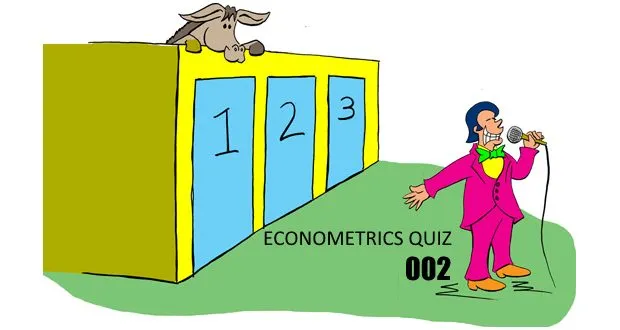93 câu trắc nghiệm Kinh tế lượng – Phần 2

KTL_002_C6_1: Which of the following are characteristics of vector autoregressive (VAR) models?
(i) They are typically a-theoretical and data driven
(ii) they can easily lead to overfitting
(iii) all variables on the right hand side of the equation are pre-determined
(iv) their interpretation is often difficult from a theoretical perspective
● (i), (ii), (iii) and (iv)
○ (i), (ii), and (iv) only
○ (i) and (ii) only
○ (i) and (iv) only
For questions 2 and 3, consider the following set of simultaneous equations:
\(\begin{array}{ccccccccccccccc}{{Y_{1t}} = }\\{{Y_{2t}} = }\\{{Y_{3t}} = }\end{array}\begin{array}{ccccccccccccccc}{{\alpha _0} + {\alpha _1}{Y_{2t}} + {\alpha _2}{Y_{3t}} + {\alpha _4}{X_{1t}} + {u_{1t}}\begin{array}{ccccccccccccccc}{}&{}&{}&{\begin{array}{ccccccccccccccc}{}&{\begin{array}{ccccccccccccccc}{}&{}\end{array}}&{(1)}\end{array}}\end{array}}\\{{\beta _0} + {\beta _1}{Y_{1t}} + {\beta _2}{X_{1t}} + {\beta _3}{X_{2t}} + {\beta _4}{X_{3t}} + {u_{2t}}\begin{array}{ccccccccccccccc}{}&{\begin{array}{ccccccccccccccc}{}&{}\end{array}}&{(2)}\end{array}}\\{{\gamma _0} + {\gamma _1}{Y_{1t}} + {u_{3t}}\begin{array}{ccccccccccccccc}{\begin{array}{ccccccccccccccc}{\begin{array}{ccccccccccccccc}{\begin{array}{ccccccccccccccc}{}&{}&{}\end{array}}&{}&{}\end{array}}&{}&{}&{}\end{array}}&{}&{}&{(3)}\end{array}}\end{array}\)
Assume that the Y’s are endogenous and the X’s exogenous variables, and that the error terms are uncorrelated.
KTL_002_C6_2: Which of the following statement is true of equation (3)?
○ According to the order condition, it is not identified
○ According to the order condition, it is just identified
● According to the order condition, it is over-identified
○ There is insufficient information given in the question to determine whether the equation is identified or not.
KTL_002_C6_3: Estimation of equation (2) on its own using OLS would result in
○ Consistent and unbiased coefficient estimates
○ Consistent coefficient estimates which might be biased in small samples
○ Inconsistent but unbiased coefficient estimates
● Coefficient estimates that are neither unbiased nor consistent.
KTL_002_C6_4: Which of the following statements is incorrect?
○ Equations that are part of a recursive system can be validly estimated using OLS
○ Unnecessary use of two-stage least squares (2SLS) – i.e. on a set of right hand side variables that are in fact exogenous – will result in consistent but inefficient coefficient estimates.
○ 2SLS is just a special case of instrumental variables (IV) estimation.
● 2SLS and indirect least squares (ILS) are equivalent for over-identified systems.
KTL_002_C6_5: Which of the following could be viewed as a disadvantage of the vector autoregressive (VAR) approach to modelling?
○ We do not need to specify which variables are endogenous and which are exogenous
○ Standard form VARs can be estimated equation-by-equation using OLS
● VARs often contain a large number of terms
○ VARs can be expressed using a very compact notation.
KTL_002_C6_6: Consider the following bivariate VAR(2):
\(\begin{array}{ccccccccccccccc}{{y_{1t}} = {\alpha _{10}} + {\alpha _{11}}{y_{1t – 1}} + {\alpha _{12}}{y_{1t – 2}} + {\alpha _{13}}{y_{2t – 1}} + {\alpha _{14}}{y_{2t – 2}} + {u_{1t}}}\\{{y_{2t}} = {\alpha _{20}} + {\alpha _{21}}{y_{1t – 1}} + {\alpha _{22}}{y_{1t – 2}} + {\alpha _{23}}{y_{2t – 1}} + {\alpha _{24}}{y_{2t – 2}} + {u_{2t}}}\end{array}\)
Which of the following coefficient significances are required to be able to say that y1 Granger-causes y2 but not the other way around?
○ \({{\alpha _{13}}}\) and \({{\alpha _{14}}}\) significant; \({{\alpha _{21}}}\) and \({{\alpha _{22}}}\) not significant
● \({{\alpha _{21}}}\) and \({{\alpha _{22}}}\) significant; \({{\alpha _{13}}}\) and \({{\alpha _{14}}}\) not significant
○ \({{\alpha _{21}}}\) and \({{\alpha _{23}}}\) significant; \({{\alpha _{11}}}\) and \({{\alpha _{13}}}\) not significant
○ \({{\alpha _{11}}}\) and \({{\alpha _{13}}}\) significant; \({{\alpha _{21}}}\) and \({{\alpha _{23}}}\) not significant
KTL_002_C6_7: Which of the following statements is true concerning VAR impulse response functions?
(i) Impulse responses help the researcher to investigate the interactions between the variables in the VAR.
(ii) An impulse response analysis is where we examine the effects of applying unit shocks to all of the variables at the same time.
(iii) Impulse responses involve calculating the proportion of the total forecast error variance of a given variable is explained by innovations to each variable.
(iv) If the standard error bars around the impulse responses for a given lag span (i.e. include) the x-axis, it would be said that the response is statistically significant.
○ (i), (ii), (iii), and (iv)
○ (i), (ii) and (iii) only
○ (i) only
● (i) and (ii) only
KTL_002_C6_8: In the context of simultaneous equations modelling, which of the following statements is true concerning an exogenous variable?
○ The values of exogenous variables are determined within the system
● The exogenous variables are assumed to be fixed in repeated samples
○ Reduced form equations will not contain any exogenous variables on the RHS
○ Reduced form equations will contain only exogenous variables on the LHS
KTL_002_C6_9: Comparing the information criteria approach with the likelihood ratio test approach to determining the optimal VAR lag length, which one of the following statements is true?
○ The choice of stiffness of penalty term will not affect the model choice
○ The validity of information criteria relies upon normal residuals
● Conducting a likelihood ratio test could lead to a sub-optimal model selection
○ An application of the univariate information criteria to each equation will give identical results to the application of a multivariate version of the criteria to all of the equations jointly
KTL_002_C6_10: The second stage in two-sage least squares estimation of a simultaneous system would be to
○ Estimate the reduced form equations
● Replace the endogenous variables that are on the RHS of the structural equations with their reduced form fitted values
○ Replace all endogenous variables in the structural equations with their reduced form fitted values
○ Use the fitted values of the endogenous variables from the reduced forms as additional variables in the structural equations.